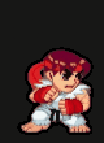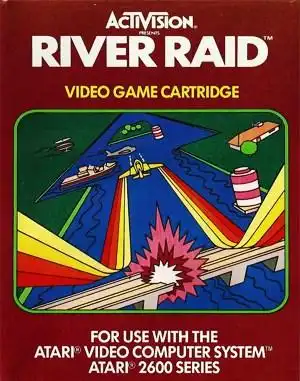Remember the days of gripping a joystick, eyes glued to the screen, dodging islands and blasting enemy ships as you sped up a seemingly endless river? If so, you likely remember River Raid. This iconic vertical scrolling shooter from Activision wasn't just another game on the Atari 2600; it was a masterclass in design that pushed the console's limits and captured the imaginations of a generation.
Let's fire up our engines and fly back into the exhilarating world of this pixelated classic.
The Thrill of the River: Gameplay Basics
At its core, River Raid is simple: you control a B1 StratoWing Assault Jet flying up the "River of No Return." Your mission? Destroy everything in your path – ships, helicopters, jets, and bridges – while staying alive.
Movement was key. Using the joystick, you could bank left and right, accelerate, slow down, and, of course, shoot. The continuous vertical scroll meant the action never stopped coming at you, forcing split-second decisions.
Fueling the Fire (and the Jet!)
One of the most distinctive and challenging elements of River Raid was its fuel mechanic. Your jet wasn't powered by hopes and dreams; it needed gas! A fuel gauge constantly ticked down, adding a layer of strategic pressure.
To survive, you had to fly directly over fuel depots scattered along the river. Refueling felt like a mini-victory in itself, especially as the river narrowed and enemies became more numerous. Running out of fuel meant a swift, fiery crash and losing a life. This wasn't just a shooter; it was a resource management sim disguised as an arcade blast!
Obstacles, Objectives, and High Scores
The river wasn't just a pretty backdrop. Islands and narrow passages required careful navigation, and colliding with the riverbanks was just as deadly as hitting an enemy.
Your primary objective was scoring points by destroying targets:
- Tankers
- Helicopters
- Enemy Jets
- Fuel Depots (destroying one while refueling was a pro move!)
- Bridges
Bridges were particularly important. Destroying a bridge not only gave you points but also served as a checkpoint. If you lost a life after blasting a bridge, you'd restart at the beginning of the next river section, not all the way back at the start.
You typically began with three reserve jets and earned an extra life for every 10,000 points scored. The ultimate goal? Achieve a high score worthy of legendary status, perhaps even earning that coveted Activision "River Raiders" patch back in the day!
The Mind Behind the Mayhem: Carol Shaw
It's impossible to talk about River Raid without highlighting its designer and main programmer, Carol Shaw. A pioneering woman in the early video game industry, Shaw leveraged her computer science background and previous work at Atari to create something truly special at Activision.
Inspired partly by arcade hits like Scramble, she wanted to create a continuously scrolling game for the Atari 2600 – a technical feat for the console. Her design process, including mapping out river layouts on graph paper, and her coding prowess resulted in one of the smoothest, most compelling experiences available on the platform. River Raid stands as a testament to her skill and vision.
Ports, Praise, and a Ban?
River Raid first launched on the Atari 2600 in December 1982 to widespread acclaim. Critics praised its fast pace, engaging gameplay, and impressive graphics for the time. It quickly became Activision's top seller and one of the best-selling games on the 2600 in 1983.
Its success led to ports on nearly every major platform of the era:
- Atari 8-bit computers
- Atari 5200
- Intellivision
- Commodore 64
- ZX Spectrum
- MSX
- IBM PCjr
- ColecoVision
While most ports were well-received, some had control quirks or slightly different graphics. Interestingly, the game faced a brief ban in West Germany in 1985 due to its perceived military theme under youth protection laws – a strange footnote for such a relatively abstract shooter!
Legacy of the River
River Raid was hugely influential, particularly in popularizing the vertical scrolling shooter genre on home consoles. Its smooth scrolling and challenging gameplay set a high standard.
Activision revisited the concept with River Raid II in 1988, though creating a sequel that lived up to the original's impact was a tough challenge. A planned third game for the Super Nintendo was ultimately cancelled.
Today, River Raid remains a beloved classic. Its simple yet addictive gameplay holds up, and its place in gaming history, especially as a showcase for Carol Shaw's talent, is undeniable.
Playing Today
Want to take a flight down the River of No Return yourself? While finding original hardware and cartridges is an option for purists, you can easily experience River Raid today through various means:
- Emulation: Using emulators like Stella (for Atari 2600) or others for different platforms on your PC.
- Digital storefronts: Sometimes included in retro game compilations on platforms like GOG or modern consoles.
- Browser-based archives: Websites like Archive.org often host playable versions of vintage games via emulators.
However you play it, River Raid offers a pure, challenging, and deeply nostalgic arcade experience.
Frequently Asked Questions
Q: Who designed River Raid? A: River Raid was designed and primarily programmed by Carol Shaw for Activision.
Q: Was River Raid the first game with continuous vertical scrolling? A: While not the absolute first (arcade games like Scramble predated it), River Raid was a significant early example that brought smooth, continuous vertical scrolling to home consoles like the Atari 2600 in a highly polished way.
Q: Why is fuel so important in River Raid? A: The fuel gauge constantly depletes, adding a crucial strategic element. Players must manage their flight path to ensure they fly over fuel depots to refuel, as running out of fuel results in losing a life.
Q: Is there a sequel to River Raid? A: Yes, Activision released River Raid II in 1988 for the Atari 2600.
Final Flight Plan
River Raid is more than just an old video game; it's a piece of history, a technical achievement for its time, and a source of countless hours of challenging fun. From its innovative fuel mechanic to the sheer thrill of navigating that ever-changing river, it's a title that perfectly encapsulates the magic of the early arcade and console era. So buckle up, pilot, the river is waiting!


